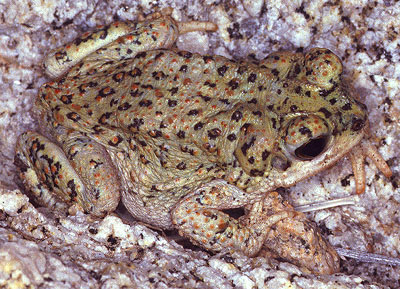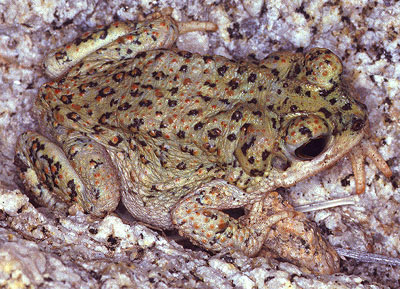Anaxyrus punctatus: The Fascinating Tale of the Red-Spotted Toad#
Under a brilliant full moon casting silver beams across desert streams, the nocturnal symphony of nature erupts into life. Crickets chirp, cicadas hum, owls call softly—but amid this chorus, one humble amphibian’s melodic trill stands out distinctly. Meet Anaxyrus punctatus, commonly known as the Red-Spotted Toad, a small yet captivating resident of arid terrains whose secretive lifestyle and stunning resilience speak volumes about the adaptability of wildlife in harsh ecosystems.
From its diminutive size and delicately dappled skin to its quiet yet melodious call reverberating in desert canyons, Anaxyrus punctatus encapsulates the beauty hidden in seemingly inhospitable landscapes. Although not as flashy as tropical frogs nor as widely known as the bullfrog or tree frog, this species’ quiet charm and ecological significance render it an essential part of America’s southwestern biodiversity.
Taxonomy and Classification#
The Red-Spotted Toad, scientifically identified as Anaxyrus punctatus (formerly classified under the genus Bufo as Bufo punctatus), belongs to the Bufonidae family, a diverse family commonly known as “true toads”. These amphibians, generally characterized by their dry, warty skin, shorter limbs, and poison-producing parotoid glands, are critical indicators of environmental health and offer invaluable insights into ecosystem wellbeing.
The revision of taxonomy and reassignment from Bufo to the genus Anaxyrus is a reflection of advanced genetic studies and careful morphological analyses conducted over the past decades. Closely related species within this genus include the Woodhouse’s Toad (Anaxyrus woodhousii) and the American Toad (Anaxyrus americanus). Yet, among its kin, the Red-Spotted Toad stands distinctive due to unique adaptations developed explicitly for life in arid, rocky terrains.
Natural Habitat#
Geographic Range and Distribution#
Anaxyrus punctatus boasts a wide yet patchy distribution throughout the southwestern United States and adjacent northern Mexico. This resilient amphibian thrives in regions characterized by rugged canyons, rocky desert washes, and riparian zones scattered across California, Nevada, Utah, Arizona, New Mexico, Texas, and even crossing into Baja California and Sonora, Mexico.
Preferred Habitat Conditions#
Unlike its moisture-dependent relatives, the Red-Spotted Toad is uniquely adapted to arid and semi-arid environments, exercising remarkable survival strategies that allow it to inhabit desert streams, rocky foothills, and ephemeral pools. Flowing streams and seasonal ponds within deserts provide temporary havens for breeding, feeding, and hydration. Rocky crevices and shaded canyon walls shelter the toads from scorching daytime temperatures and predators alike, providing crucial microclimates for their survival.
During dry periods—as water sources vanish, leaving baked mudflats and cracked earth—Red-Spotted Toads employ a remarkable behavioral adaptation: aestivation. Burrowing into loose soil or snug crevices, these amphibians patiently enter a dormant period, waiting for the return of rains to reawaken them.
Physical Characteristics#
The Red-Spotted Toad captivates observers with its subtly impressive aesthetics. It typically reaches a modest adult size of around 3.8–7.5 centimeters (1.5–3 inches), making it one of the smaller members among North America’s true toads. However, what it lacks in size, it more than compensates for in visual distinction.
The surface of its squat, rounded body features a beautiful grayish-green or olive coloration accented by delightful orange to reddish spots surrounded by conspicuous black borders scattered across its back. These vibrant spots lend the species its common name and provide exquisite camouflage, allowing the toad to blend harmoniously with its rocky and earthen environment.
Its dry, warty skin prevents excessive water loss, an adaptation crucial for survival in desert climates. Notably, compared to other toads, the Red-Spotted Toad’s warts are smaller and less pronounced, producing a smoother appearance overall. Prominent elliptical pupils nestled within golden-copper eyes give the species remarkable vision adapted to a nocturnal lifestyle.
Behavior and Life Cycle#
Feeding and Hunting Habits#
An opportunistic carnivore, this small, agile amphibian feeds primarily on a diet comprising insects and arthropods inhabiting its desert ecosystem. Ants, beetles, spiders, grasshoppers, moths, and various larvae contribute significantly to its nutritional needs. Although generally ground-dwelling, Red-Spotted Toads occasionally climb small rocks and vegetation during feeding forays, precisely flicking out their sticky tongues to capture unsuspecting prey swiftly.
Reproduction and Life Stages#
The arrival of seasonal rains triggers one of nature’s captivating spectacles—thousands of Red-Spotted Toads emerge almost instantaneously from their concealed retreats. Vocal choruses echo amongst canyon walls as males melodically trill from shallow pools and ephemeral ponds, tirelessly calling potential mates through the damp, moonlit nights.
After successful mating, females deposit gelatinous strings of eggs—containing hundreds or thousands of embryos—into temporary pools. Remarkably, the embryos hatch rapidly, usually within just a few days, a critical adaptation perfectly suited to precariously brief desert water availability. The tadpoles, dark-colored, small, and remarkably well adapted, race against time, rapidly developing legs, lungs, and terrestrial adaptations, maturing completely in just a few weeks. Juveniles then bravely disperse into harsh deserts, employing instinctive survival techniques well beyond their apparent vulnerability.
Ecological Role#
Indicator Species and Predator-Prey Dynamics#
Red-Spotted Toads play a critical ecological role, serving as prey, predator, and bio-indicator within their ecosystem. They help control insect populations, suppressing potential pests and promoting ecological equilibrium. Simultaneously, this small amphibian occupies a vital place in food webs, serving as sustenance for birds, snakes, mammals, and larger amphibians. Their presence and health are indicative of environmental integrity. A thriving population signals a healthy, balanced ecosystem, while declining numbers can accurately flag environmental distress, pollution, or habitat deterioration.
Threats and Conservation Status#
Currently categorized as Least Concern by the International Union for Conservation of Nature (IUCN), Anaxyrus punctatus populations are deemed relatively stable across much of their range. Still, like many amphibians worldwide, Red-Spotted Toads face significant natural and anthropogenic threats.
Habitat Loss and Human Activity#
Urbanization and the conversion of natural habitats into agricultural, residential, or industrial lands negatively impact these frogs’ breeding and feeding niches. Human interference often disrupts delicate desert water regimes, essential to their life cycle. Pesticide runoff, invasive species, prolonged drought conditions exacerbated by climate change, and exposure to the deadly chytrid fungus pose significant cumulative threats. Ongoing ecological monitoring and conservation planning remain imperative in safeguarding their fragile desert habitats.
Cultural and Scientific Significance#
Although not extensively celebrated in folklore like other species, Indigenous cultures in the American Southwest have traditionally understood amphibians like the Red-Spotted Toad as important symbols, often signifying water, life renewal, and transformation—reflecting traditional ecological knowledge accumulated through generations of environmental observation.
As scientific inquiry progresses, Anaxyrus punctatus continues to offer critical insights into desert ecosystem health and climate adaptation strategies. Understanding how this small creature thrives and adapts provides researchers with valuable indicators necessary in developing robust conservation models and informing climate resilience policies in arid ecosystems.
Conclusion: A Call to Protect Desert Jewels#
From its elusive appearances beneath desert moonlight to its fascinating reproductive strategies tailored to temporary rainfall, Anaxyrus punctatus embodies the remarkable tale of life’s persistence under extreme environmental conditions. Protecting this fascinating amphibian means safeguarding the delicate desert habitats on which countless other species also depend.
While the Red-Spotted Toad may be small and seemingly modest, it invites all of us—as nature enthusiasts, explorers, students, and conservationists—to delve deeper into appreciating our ecosystems’ fragile balances. Through ongoing awareness, activism, and education, let us preserve the vibrant story of the Red-Spotted Toad, the resilient jewel of the American Southwest.













